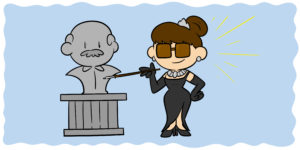There are many occasions where readers don’t care about historical accuracy. Traditional fantasy stories take place in a semi-medieval period with no clear beginning or end, romance tales tend to soften historical attitudes to create protagonists we can actually root for, and subgenres like steampunk thrive on injecting a little novelty into real history.
If that’s what you’re writing, your research can stop at the general historical ‘vibe.’ If, however, you’re writing something where historical accuracy is part of the appeal – historical fiction, period fiction, creative nonfiction or even alternate history fiction – then you need to go further.
This is where anachronisms come into play. An anachronism, put simply, is a thing depicted in the wrong time period. A car in the Jurassic era; an escape scene that takes place in the tunnels under Paris before those tunnels were built; or teens texting each other in a 1960s high school.
So, do these tiny details really matter and, if so, how can you make sure you get them right? Today’s article will answer these questions by talking about reader trust, the power of imagination, and the importance of careful research. We’ll also look at some tips for banishing anachronisms from your writing, no matter your time period.
The details matter because they help readers suspend disbelief
Stories are powerful, they are how humans have grappled with the world and talked about deeper truths for as long as we’ve had language, but our willingness to suspend disbelief and engage in a story is still dependent upon what that story can deliver and its ability to create a believable world.
Readers, knowing that fiction is contrived, are willing to suspend disbelief for the sake of the story and the feeling of being entertained. Maintaining a reader’s choice to believe requires a coherent setting, interesting plot, and believable characters. When these elements are in sync, readers are willing to let fiction feel real, even when they know it’s not. It’s almost as if they’ve entered into a trance in which unreal things feel real.
Anachronisms break the trance. Civil War era bacon wasn’t wrapped in cellophane. People didn’t visit serve-yourself frozen yogurt shops in 2005. Inaccurate details inadvertently ask readers to believe something that it’s unreasonable to believe. They lose their willingness to suspend disbelief, and they are no longer engaged in the story.
The details matter because readers trust you
Think about the process of getting lost in a good book. You hand yourself over to the author and, once you know that you’re in good hands, you let yourself be swept along by the story, allowing the writer to do a little of your thinking for you.
By this, I mean that you’re not constantly asking, “Would that character really do/say that? Is that really the logical decision? Is what just happened believable?” Having developed some trust in the author, you accept that they’re telling a reasonable story unless something explicitly unreasonable comes along, and then the trust is broken.
Consider if C.S. Lewis had written Susan’s infamously anachronistic movie line, the one that had Narnia fans ready to storm Disney in protest: ‘You might need to call me again.’ Moviegoers tend to be more forgiving, since visual effects are so enthralling and because movies represent a smaller time investment than books, but put that quote in a book and watch readers act as if they’ve been betrayed – because they have.
Up until then, readers trusted that you, the author, were writing a realistic depiction of children living in that time period going through those experiences. When it turns out that you haven’t actually put in the effort, they suddenly start to wonder what other silly details they accepted as fact. Even if it was an honest mistake, the reader is still left feeling foolish. In this way, breaking trust can be even more harmful than breaking suspension of disbelief, since the reader doesn’t just distrust whatever you say next, they distrust what you’ve already told them.
Deciding which anachronisms kill and which you can let slide
Most successful authors are pretty perfectionist. If a newspaper ceased publication in 1967, they’re not going to have a character pick up a copy from a newsstand in 1968. They know what year the last Oldsmobile was manufactured, and they know when kids started – and stopped – saying ‘beep me.’ They know when Brahms lived and died and that Wagner was his arch-rival. They won’t sell frozen peas until 1920, when such a world-changing novelty made its debut.
Does that mean if you don’t track down and neutralize every mistake like you’re on a military operation that your book can’t possibly be successful? Not necessarily. Some books go viral without even checking for proper grammar first (cough, cough, The Shack). A Gentleman in Moscow was very successful (and delightful) despite mentioning ‘baby carrots’ well before their time.
While trust and suspension of disbelief are at risk around anachronisms, the contract you make with your reader will always be subtly different. Most historical fiction tweaks language a little to make characters more comprehensible to a modern audience, and there are many circumstances in which even the stuffiest readers won’t care about details that they consider beside the point of your story.
Your job as an author isn’t to do so much research that every aspect of your setting, characters, and plot is historically accurate. No, your job is to decide where accuracy matters and where it doesn’t.
Making the call
Most of the time, it’s better to get everything right. Even if readers don’t notice minor mistakes, small, vivid, precise details have a lot of power to bring stories to life. If you can’t track down the details you need, it’s better to be vague than to be wrong. Match every vague reference with a vivid one. Don’t leave any stones unturned, so that if there is a mistake in your manuscript, it’s not because you were cutting research corners. If there’s something you can’t find or confirm, ask someone in the field (often easier than you’d think). Ask Google. Ask your editor. Go to the library.
Setting the tone
For overall tone, it’s helpful to immerse yourself in your chosen time period. Curl up with piles of fiction and nonfiction from your chosen era. Indulge in movies set in that era. Consume, consume, consume.
Just as you pick up an accent that isn’t yours if you spend too much time in Tennessee, total immersion means you begin to think and talk like someone from that time and place. You’ll be automatically inclined to exclude things that don’t belong.
Gathering data
Particularly for recent periods; TV shows, movies, and speeches can be very useful in terms of language used and content people cared about. If there’s a word or expression you’re unsure of, Google Trends or Merriam Webster’s online dictionary can be used to confirm the popularity of various expressions.
Author and video-essayist Lindsay Ellis has been tweeting a humorous collection of words she can’t use in her upcoming book, which is set in 2008, deriving her info from Google trends. It’s a remarkable feat of multitasking: she’s using her research to engage readers before the book is even written.
Broadening your scope
It goes without saying that any historical time frame should be researched meticulously: books written about that time and during that time. You’ll get a leg-up not only on the kinds of language used during that time, but what relationships looked like, where people shopped, what they ate and drank, where they met, who cut their hair, what they did on first dates, etc.
Beyond books, access as many different resources from your chosen time as possible. Study paintings, find out who was famous and read their speeches, know what the music was like and listen to it if possible. Are photographs available from your time period? Perfect. What did kids study in school at that time? Can you find copies of their curricula? What were the most common jobs and how much money did people make? What did restaurants serve? Had department stores been invented yet? Where did most people get their drinking water? What did rich people have that most people didn’t? The answers vary more than you might think – lobster might be considered a delicacy in 2020, but in 1674 it was a poor man’s meal. Times really do change.
This type of research won’t just prevent errors; it’ll infuse your writing with a sense of realism and historical insight. It’s also a great way to find inspiring tidbits to include in your story. For instance, imagine if I asked you to write a scene in which two medieval Christian theologians were having an argument. What subject would you choose for their disagreement? You’re a writer, so I’m guessing your answer was pretty good, but it wasn’t as good as cannibal babies.
For once, it’s okay to assume
The best thing you can do for your historical fiction book? Assume that everything was different. Everything. Even if you’re writing about a recent year, never in history have things changed so rapidly as in the 21st century. Technology is vastly different than it was just a couple of years ago. Or ask any high school teacher today about the slang kids use: it’s like a foreign language.
Even if you’re writing in contemporary times, you have to assume that how a person talks, what they own, and what they do to pass the time will vary depending on their age and where they live along with a multitude of other factors. How much more so when you’re writing in another year, decade, or century. So unless your book is autobiographical, presuppose that everything will be different from what you’re used to.
You have somebody cooking something in 1898? Great. What are they cooking? It’s probably not skirt steak. Also, the kitchen will be different. No counters, probably, and no cabinets either.
Sound exhausting? It is. To be a successful writer, you have to put in the time and effort.
Kill your darlings, not your whole book
If you want to write great historical fiction, your readers are going to need to feel like they fell into a deep sleep and woke up in a different world. To create that different world, you’re not only going to need to have all your facts straight, you’re going to need to paint a picture with all the right colors. Meticulous research and total immersion aren’t optional; they are 100% necessary. You want to live in the world you are writing in for a little while. Mid-book, if a piece of toast somehow appears on Cleopatra’s plate, you should be just as surprised as she is.
So, that’s how you can avoid anachronisms in your writing. But, wait… What if you discover something true that just sounds like it must be an anachronism? Well, that’s a circumstance known as the Tiffany Problem, but we’ve got you covered there too, with How You Can Overcome The Tiffany Problem In Your Writing.
Has an anachronism disrupted your reading experience? Do you have any interesting time-period facts to help other authors? Share in the comments below, and check out The 3 Golden Rules Of Writing Period Fiction and Alternate History Fiction: 3 Useful Rules You Should Know for more great advice on getting history right.






3 thoughts on “Anachronisms Kill Historical Fiction – Here’s How To Stop Them”
Hi! For some reason I can’t figure out why Susan’s comment was historically anachronistic. Would you mind explaining? (It’s really bothering me ?)
Hi, Molly, thanks for reading.
Susan’s line is a play on the more modern flirtatious expression “call me.” It doesn’t really fit the way kids would have talked in World War II England much less the medieval-esque time frame of Narnia itself.
Funny how “call me” is now increasingly an expression of the past!
Best wishes,
Rebecca Langley
Love this! I completely agree with what you have written. I hope this post could reach more people as this was truly an interesting post.